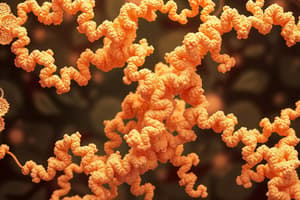Podcast
Questions and Answers
What does increased enthalpy and decreased entropy result in?
What does increased enthalpy and decreased entropy result in?
increase in Gibbs energy
Why do oil and water mix cause oil droplets to coalesce into larger drops and even separate into two phases?
Why do oil and water mix cause oil droplets to coalesce into larger drops and even separate into two phases?
reducing Gibbs energy and making separation spontaneous and energetically favored
What is an example of an amphipathic molecule?
What is an example of an amphipathic molecule?
- Protein
- Phospholipid (correct)
- Water
- Glucose
What is the characteristic structure of phospholipids?
What is the characteristic structure of phospholipids?
What creates an attractive force between the hydrophilic structure and water?
What creates an attractive force between the hydrophilic structure and water?
What type of bond involves atoms sharing or giving up electrons from their outermost shell to bond and create a new substance?
What type of bond involves atoms sharing or giving up electrons from their outermost shell to bond and create a new substance?
Which type of bond forms oppositely charged ions due to electron transfer from atoms?
Which type of bond forms oppositely charged ions due to electron transfer from atoms?
Metallic bonding is crucial for preserving the three-dimensional structures of proteins and nucleic acids.
Metallic bonding is crucial for preserving the three-dimensional structures of proteins and nucleic acids.
______ are forces affecting biomolecule conformation and are manifestations of electromagnetic force generated by protons and electrons.
______ are forces affecting biomolecule conformation and are manifestations of electromagnetic force generated by protons and electrons.
Match the forces with their descriptions:
Match the forces with their descriptions:
Flashcards are hidden until you start studying
Study Notes
Chemical Bonds
- Chemical bonds involve atoms combining to form chemical compounds, bringing stability to the resulting product.
- There are two main types of chemical bonds:
- Ionic bonds: form when valence electrons are completely removed from an atom and "donated" to the neighboring atom.
- Covalent bonds: typically have various amounts of flexibility, allowing for movements such as free rotation, bending, compression, extension, and twisting.
Movement in Chemical Bonds and Molecular Conformation
- Forces causing molecule motions can balance restoration force, resulting in atom vibration and various vibrational states with specific frequencies for covalent bonds.
- Bond movements can also allow for multiple paths between two different conformations.
- There are two ways to move from conformation A to conformation B:
- Through free rotation of the bond between atoms.
- Through bending.
Forces Affecting Conformation in Biomolecules
- The forces affecting biomolecule conformation are electrical, resulting from charges' attraction or repulsion.
- These forces are manifestations of electromagnetic force generated by protons and electrons in biological molecules.
- Van der Waals forces, other than covalent and ionic bonds, play the largest role in molecular associations, while forces within the molecule indirectly influence conformation.
- Charge-Charge Forces:
- The force between two electrostatic charges is defined by Coulomb's law.
- The force F, two charges q1 and q2, distance r, and a constant ke are all crucial factors in a vacuum model.
- Dipole Forces:
- An electric dipole is defined as two equal and opposite charges separated by a fixed distance.
- The dipole moment is equal to the magnitude of the charge at one end of the dipole, times the fixed distance between the two charges.
Charge-Dipole Forces
- The potential energy between an ion and a dipole is the sum of the potential energy between the ion and the charges in the dipole.
- It depends on the dipole's orientation relative to the charge and is inversely proportional to the square of the distance between the charge and the dipole.
- The potential energy decreases faster with distance in charge-dipole interactions.
Dipole-Dipole Forces
- The main differences between charge-dipole interactions and dipole-dipole interactions are:
- Two dipoles interact, resulting in four charges compared to three in a point charge and a dipole.
- Each dipole has two different angles, unlike a single angle in the orientation between a point charge and a dipole.
- The potential energy function, F(a1, b1, a2, b2), is a function of four angles a1, b1, a2, b2.
- It decreases with distance cube, square, and charge-charge interactions, indicating that more charges have a higher power on the inverse relationship with distance and shorter interaction range.
Hydrogen Bonds in Water
- Water is a highly polar molecule, with a permanent dipole.
- Oxygen atom is partially negative, and hydrogen is partially positive.
- Molecules of water are V-shape, with an unsymmetrical shape and unequal sharing of electrons between the atoms.
- Hydrogen bonds are crucial for preserving the three-dimensional structures of proteins and nucleic acids.
Hydrophobic and Hydrophilic Interactions
- Hydrophobic interactions:
- Are interactions between water and a non-polar substance.
- Don't involve a single, physical force.
- Also called hydrophobic forces.
- Hydrophilic interactions:
- Easily hydrogen bond with water.
- Create an attractive force between the hydrophilic structure and water.
- Amphipathic or amphiphilic molecules:
- Are both hydrophobic and hydrophilic.
- Examples include phospholipids, which make up the membrane of cells.
Studying That Suits You
Use AI to generate personalized quizzes and flashcards to suit your learning preferences.



